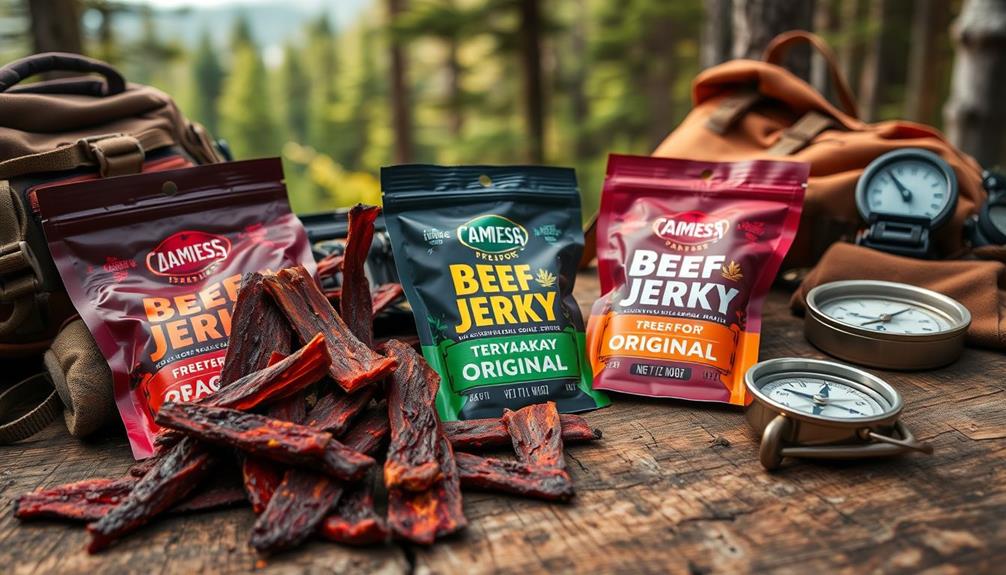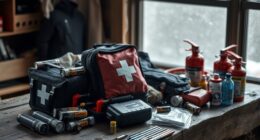You're part of a growing movement of individuals preparing for catastrophic events, driven by a sense of uncertainty and insecurity in the world, and you're not alone – millions of people worldwide are taking steps to secure their survival in the face of potential disasters. Doomsday preppers come from diverse backgrounds, united by a common goal of survival. They invest in doomsday bunkers, survival training, and stockpiling resources to face scenarios like EMP attacks, foreign occupation, or nuclear strikes. From extreme survivalists to those seeking self-sufficiency, preppers are ready to thrive in challenging circumstances. Want to know more about the world of extreme survivalists and how they prepare for the worst?
Key Takeaways
- Doomsday preppers prepare for catastrophic events by investing in bunkers, survival training, and stockpiling resources to ensure survival and self-sufficiency.
- Extreme survivalists focus on building fortified shelters, stockpiling essentials, and developing survival skills to thrive in challenging circumstances.
- Preppers stockpile non-perishable food, water, and medical supplies, and implement rotation systems to ensure a year's worth of sustenance.
- Luxurious underground bunkers are equipped with high-tech security measures, opulent amenities, and advanced life support systems to provide a safe haven.
- Developing essential survival skills, such as wilderness first aid, self-defense, and navigation, is crucial for preppers to survive post-catastrophe.
The Rise of Doomsday Preppers
As the world becomes increasingly unpredictable, you're not alone if you've found yourself wondering what it takes to prepare for the worst, and a growing number of individuals are taking drastic measures to guarantee their survival in the face of catastrophic events. These individuals, known as doomsday preppers, might be a good example of people who are taking their fears of the end of the world seriously. They're not just preparing for minor disruptions, but for full-blown catastrophes that could bring society to its knees.
The rise of doomsday preppers can be attributed to the growing sense of uncertainty and insecurity in the world. With natural disasters, economic collapse, and global conflicts on the rise, it's no wonder people are taking matters into their own hands.
Preppers come from all walks of life, from retired analysts to veterans, and they're all driven by a common goal: to survive the unthinkable. By investing in doomsday bunkers, survival training, and stockpiling resources, they're preparing for any scenario that might arise.
Whether it's an EMP attack, foreign occupation, or nuclear strike, doomsday preppers are ready to face whatever the future holds.
Preparing for the Worst Case

How far would you go to guarantee your survival in the face of catastrophic events, and what measures would you take to prepare for the worst-case scenarios that keep you up at night? For extreme survivalists, the answer is simple: they'll do whatever it takes.
These preppers focus on self-sufficiency, stockpiling essentials like food, water, and weapons, and building fortified shelters to survive catastrophic events. They're not just preparing for natural disasters or economic collapse; they're preparing for the end of the world as we comprehend it.
To assure their survival, preppers invest significant time and resources into readiness, training, and securing their survival plans. They believe in being prepared for any eventuality, no matter how unlikely. Some preppers believe in prophecies and signs of impending doom, while others simply want to be ready for anything life throws their way.
Whatever their motivations, one thing is clear: these preppers are serious about survival. They're not just preparing for the worst case; they're preparing to thrive in it.
Stockpiling for Survival

As you prepare for the unexpected, stockpiling the right supplies is essential.
You'll need to think strategically about food storage, considering strategies like canning, dehydrating, and vacuum sealing to extend shelf life.
Next, you'll want to focus on water hoarding methods and emergency ration plans to make sure you have enough sustenance to last through any disaster.
Food Storage Strategies
You're likely to find a prepper's pantry stocked with a diverse range of non-perishable foods, carefully selected to provide sustenance during extended periods of uncertainty. These preppers understand the importance of food storage strategies to guarantee their survival.
Here are some key strategies they use:
- Stocking up on non-perishables: Canned goods, rice, and beans are staples in a prepper's pantry due to their long shelf life.
- Investing in specialized foods: Freeze-dried foods and MREs (Meals Ready-to-Eat) are used for extended storage periods, providing a reliable source of nutrition.
- Implementing food rotation systems: Preppers use these systems to make sure older supplies are used first, maintaining freshness and minimizing waste.
- Storing seeds for long-term sustainability: By storing seeds, preppers can grow their own food if needed, providing a sustainable source of nutrition.
Proper storage containers, such as Mylar bags and food-grade buckets, are also essential to protect stored food from pests and moisture. By implementing these strategies, preppers can rest assured that they've a reliable source of food to sustain them during uncertain times.
Water Hoarding Methods
When it comes to stockpiling for survival, having a reliable food supply is only half the battle – you'll also need a steady supply of clean drinking water, which is why doomsday preppers go to great lengths to hoard this precious resource.
Water hoarding methods include collecting rainwater, digging wells, and using filtration systems to guarantee a constant supply. Preppers also stockpile water purification tablets as a backup plan.
To maintain water quality, preppers rotate their stored water, add chlorine for disinfection, and monitor for contaminants. Long-term water storage solutions involve burying water caches, utilizing underground cisterns, and implementing water recycling systems.
You'll also find preppers stockpiling water bottles, jugs, and pouches, as well as investing in water treatment equipment for emergencies. By taking these measures, doomsday preppers can rest assured they'll have access to clean drinking water, even in the most uncertain of times.
Emergency Ration Plans
One essential aspect of doomsday prepping is stockpiling emergency rations, which typically include a year's worth of non-perishable food, water, and medical supplies to sustain you and your family during a prolonged crisis. This preparedness approach guarantees you're self-sufficient in the face of uncertainty.
To achieve this, you'll need to curate a well-rounded emergency ration plan. Here are some essentials to include:
- Canned goods: Non-perishable and nutritious, canned foods like vegetables, meats, and soups are a staple in many preppers' stockpiles.
- Freeze-dried meals: Lightweight and compact, freeze-dried meals provide a convenient and energy-rich option for survival.
- Energy bars: High-calorie energy bars are perfect for quick energy boosts during emergencies.
- Bulk grains: Stockpiling bulk grains like rice, oats, and wheat ensures a steady supply of carbohydrates for sustenance.
Remember to regularly rotate your emergency rations to maintain freshness and effectiveness. Check expiration dates and replenish supplies as needed to guarantee your stockpile remains viable.
Building the Ultimate Bunker

Doomsday preppers like Robert Vicino are transforming abandoned nuclear shelters into luxurious underground havens, equipped with cutting-edge technology and opulent amenities designed to sustain life for extended periods. These bunkers are built to last, with high-tech security measures in place to protect against potential threats. You'll find beds costing thousands of dollars, guaranteeing a comfortable stay for you and your loved ones. Vicino's plans extend beyond the US, with bunkers set to be built in Australia, providing a safe haven in high-risk situations.
As you step into these underground retreats, you'll be amazed by the attention to detail. Every aspect is designed to ensure your safety, unity, and preparedness for any situation. From advanced life support systems to state-of-the-art communication networks, these bunkers have it all. Whether it's a natural disaster or a global crisis, you'll be ready to face it head-on.
With doomsday preppers like Vicino leading the way, you can rest assured that these bunkers will provide a safe and comfortable environment to ride out any storm.
Survival Skills for the Future

As you prepare for the unknown, it's essential to focus on developing essential survival skills that'll help you thrive in a post-catastrophe world.
You'll need to stock up on the right gear, know how to treat injuries in the wilderness, and defend yourself against potential threats.
Essential Gear Checklist
As a doomsday prepper, you'll need a solid arsenal of essential gear to increase your chances of survival in the face of uncertainty, and that starts with the basics: water purification tablets, fire starters, and multi-tools. These fundamental items will help you access clean drinking water, start a fire for warmth and cooking, and perform various tasks with ease.
Here are some additional must-haves to include in your gear checklist:
- Emergency blankets: Lightweight and compact, these blankets will keep you warm in extreme cold.
- First aid kits: A well-stocked first aid kit will help you treat minor injuries and prevent infections.
- Compasses: A reliable compass will make sure you stay on course and find your way back to safety.
- Signaling devices: Whistles, flares, or mirrors can assist you in signaling for help in case of an emergency.
Wilderness First Aid
You'll need to know how to treat injuries and illnesses when medical help is scarce, which is where Wilderness First Aid comes in – an essential skillset for survivalists preparing for the worst. This critical skill teaches you how to handle medical emergencies in remote locations where professional help is limited or unavailable.
In a survival situation, knowing Wilderness First Aid can mean the difference between life and death.
Wilderness First Aid courses cover a range of topics, including wound care, fractures, hypothermia, and improvised medical techniques. You'll learn how to treat injuries and illnesses using minimal equipment, making it an invaluable skill for preppers preparing for natural disasters, societal collapse, or other emergencies.
Self-Defense Tactics
When the rules of society break down, your ability to defend yourself and your loved ones becomes the ultimate survival skill. On Doomsday Preppers, extreme survivalists showcase their self-defense tactics, emphasizing the importance of being prepared for the worst.
These tactics include firearms training, hand-to-hand combat skills, and strategic planning for defending against potential threats.
Here are some key self-defense strategies employed by extreme survivalists:
- Firearms training: Developing proficiency in using guns to protect yourself and your family.
- Hand-to-hand combat skills: Learning techniques to defend yourself in close quarters without weapons.
- Strategic planning: Identifying potential threats and developing a plan to counter them.
- Weapon proficiency: Mastering the use of knives, bows, and other weapons for self-defense.
Community and Unity in Crisis

In the face of catastrophic collapse, doomsday preppers band together, forging strong bonds and a sense of community that becomes an essential tool for survival.
You'll find that preppers prioritize community and unity in crisis situations, emphasizing the importance of teamwork and mutual support. This unity is driven by shared concerns about global events, societal collapse, and the need for self-sufficiency in times of anarchy.
As you explore the doomsday prepping community, you'll meet individuals from diverse backgrounds, including teachers, psychologists, military veterans, public servants, and retired professionals. Despite their differences, they're united in their commitment to preparedness and their desire to establish a lasting legacy of readiness for future generations.
In a post-disaster world, preppers know that safety and security will depend on their ability to work together. That's why they place a high value on safety, security measures, and maintaining a strong sense of camaraderie. By doing so, they can face potential threats together, providing each other with emotional support, shared resources, and collective expertise.
In the world of doomsday preppers, community and unity are the keys to survival.
The Psychology of Fear and Prep

As you explore the minds of extreme survivalists, it becomes clear that their psychology of fear is fueled by a deep-seated belief that the worst-case scenarios aren't only possible, but inevitable. This fear drives them to prepare for the unknown, investing in a fearful future and prioritizing self-sufficiency.
Here are 4 key aspects of the psychology of fear and prep:
- Global event concerns: Survivalists are worried about global events like wars, natural disasters, and societal instability that could disrupt their lives.
- Worst-case scenario thinking: They believe in being prepared for the worst, no matter how unlikely it may seem.
- Self-sufficiency mindset: Preppers prioritize self-sufficiency, wanting to be able to rely on themselves in times of crisis.
- Prophecies and beliefs: Some survivalists hold beliefs based on prophecies from the Bible or other sources, adding a spiritual dimension to their preparations.
Doomsday Scenarios and Reality

Your doomsday scenario is probably filled with catastrophic events like economic collapse, natural disasters, and societal breakdown, which is why you're preparing for the worst. Many preppers believe in signs of impending doom from wars, prophecies, and societal instability. They're convinced that these events will lead to a breakdown of society, making it essential to be prepared.
Survivalists focus on self-sufficiency, readiness for anarchy, and stockpiling supplies like food and weapons. They invest in doomsday bunkers with amenities for long-term survival and high security measures. These bunkers are designed to withstand natural disasters and provide a safe haven during times of chaos.
It's not just about individual survival; the doomsday prepper community emphasizes unity, legacy, and preparedness for worst-case scenarios. They believe that by working together, they can increase their chances of survival and rebuild society after a catastrophic event.
Frequently Asked Questions
When Was the Last Episode of Doomsday Preppers?
You might be shocked to know that only 45 episodes aired before the show ended Did you wonder when the last episode of Doomsday Preppers aired? It was on March 4, 2014, marking the series' conclusion.
Are Preppers and Survivalists the Same?
You're wondering if preppers and survivalists are the same? Nope While both prepare for catastrophic events, preppers focus on stockpiling supplies, whereas survivalists emphasize self-reliance and wilderness skills for long-term sustainability.
Is Doomsday Preppers Still on Tv?
You're wondering if Doomsday Preppers is still on TV? Unfortunately, it's not. The show aired for four seasons from 2012 to 2014 and is no longer in production, but you can still stream it online.
What Is the End of the World Survivalists?
You're wondering what end of the world survivalists are? Imagine a secret society of ultra-prepared individuals, driven by fears of global chaos, who stockpile, train, and bunker down to outlast the apocalypse, safeguarding their families and future.
What Are the Reasons Behind Doomsday Preppers’ Extensive Stockpiling?
Doomsday preppers’ extensive stockpiling is driven by a variety of reasons, including fear of societal collapse, natural disasters, or economic meltdown. The exposed stockpile of preppers reflects their belief in being self-sufficient and prepared for any worst-case scenario. They prioritize security and autonomy in uncertain times.
Conclusion
As you peer into the world of doomsday preppers, you're left with a lasting impression – these individuals are the anchors in a stormy sea, holding fast against the unpredictable tides of disaster. Their preparations are a demonstration of human resilience, a beacon of hope in the darkest of times.
Whether you're a fellow prepper or simply curious, one thing is certain: their dedication to survival is a powerful reminder that even in the face of uncertainty, humanity can persevere.










